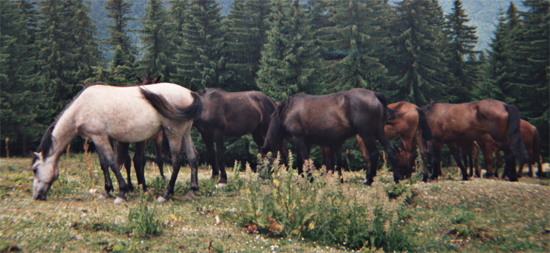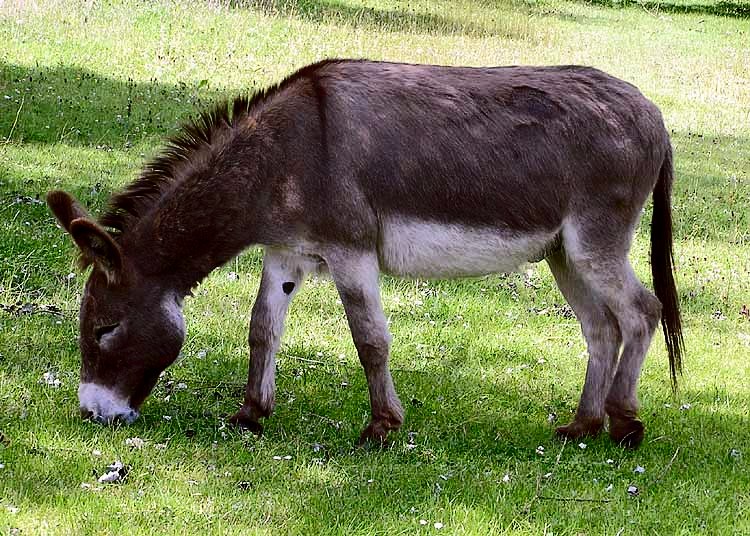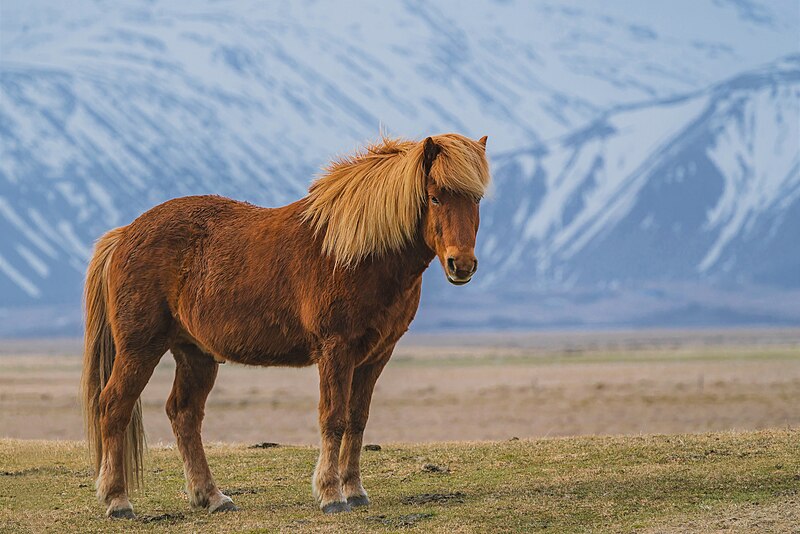Equines - Horses & Donkeys
See our RP Guide for more extensive information regarding horses.
Introduction
|
On this page... (hide)
Equines on found and used on ‘Souls include Livestock animals such as horses, donkeys, and their hybrids. Luperci from more advanced and sophisticated societies may be quite knowledgeable and well-versed in the usage, benefits, and care of equines, and are more likely to have these animals as companions. On the contrary, non-shifters and more “feral” Luperci are more likely to see equines as prey animals, be afraid of them or regard them with caution, and/or act aggressively towards them. Approaching an equine while in Lupus or Secui might make one be more readily perceived as a threat due to hundreds of years of natural evolution and instincts in avoiding dangerous predators such as canines. Players and characters may use terminology such as “feral” and “wild” horses/donkeys interchangeably, but, it should be noted that true “feral” equines are not synonymous with true “wild” equines. For example, the “wild” horse herds from the American Midwest originated from formally domesticated horses brought over from Spain, and are not the same as the truly wild Prezwalski’s horse of Mongolia, which never stemmed or originated from a domesticated group. Non-domesticated Equus species — such as the zebra, onager, or kiang asses — are prohibited due to their rarity and lack of domestication. |
1. Speech
According to our Speech Guide, this creature speaks Low Speech naturally. It is therefore not able to communicate with Luperci. This creature is listed as having the ability to learn some limited comprehension of high speech, but generally will never be able to speak it.
2. Uses
- Food: With the abundance of other, easier and more “natural” prey animals, horses are not often hunted down for their meat, and their ability to produce powerful kicks and vicious stomps often makes them a risk not worth taking. However, desperate times may call for desperate measures, and a valiant steed may need to be sacrificed.
- Horse meat is lean, is often said to have a sweet and slightly gamey taste, and is something of a blend between beef (cow) and venison (deer). Younger horses yield meat that are more pinkish in color, whereas older ones are darker and redder. Horse killed during late-autumn will yield more fat than during the spring and summer.
- By-Products:
- Pelts and hides: As with any animal, hides and pelts can be made from equines.
- Horse leather: Horse hide yields a smooth leather, and is comparable to bullhide. It is more rigid than cowhide, and takes longer to break-in. The hide’s coarser grain also lends to a brighter, shinier appearance. Dying horse hide can be difficult, and lead to ununiform colors compared to cowhide.
- Horse Hair: Killing the animal is not necessary to obtain this by-product, as it can simply be plucked or cut from the animal. This can be used for things such as brushes and fishing line (if multiple strands are spun together).
- Horse Glue: Made from boiling connective tissues (skin, tendons, bones, hooves, etc.).
- Hoof Glue: Best used for wooden surfaces; does not leave any visible marks.
- Pelts and hides: As with any animal, hides and pelts can be made from equines.
- Companionship: More commonly, horses are valued by Luperci for their companionship and usefulness as beasts of burden. (See our RP Guide for more information on obtainment)
- Travel: While Luperci may be able to travel great distances in Lupus or Secui, some prefer to remain in Optime for various reasons. Benefits to an equine include being able to carry things; from gear to personal possessions and items of trade to Luperci themselves. Having a horse or mule can also significantly reduce travel times over short distances for Optime individuals.
- Labor: Equines can pull more weight than Luperci, and can see a variety of uses from moving downed trees or boulders, to pulling plows, to pulling carts/wagons/sleds, to name a few.
- Livestock Guardian: Donkeys and Mules can make decent guardians over sheep, goats, and other small livestock. While they can challenge smaller predators such as foxes, coyotes, and bobcats, they may fair poorly against larger ones such as wolves, bears, or cougars.
3. Types
3.1 Donkey↪ Donkey (Equus africanus asinus), aka burro, ass |
| Useful Information |
|
| Quick Facts |
|
| Sizes |
|
| Appearance |
3.2 Horse↪ Horse (Equus ferus caballus) |
| Useful Information |
Wild herds often consist of smaller “bands” of horses which share the same territory. Bands are often led by a dominate mare (aka “lead mare” or “boss mare”), and usually have a single, dominate stallion (aka “lead stallion”) with less-dominant stallions remaining on the fringes of the group or forming bachelor bands. Lead stallions are protective of their bands, often patrolling around their harem and challenging threats from predators or other stallions. See our RP Guide for additional information on general temperaments by sex.
|
| Quick Facts |
|
| Sizes |
|
| Appearance |
| Hinny |
|
Hinnies are the offspring of a male horse and a female donkey, and are less common than mules. They tend to have shorter ears, stronger legs, and thicker manes. They often range to be 6-15 hands (24-60 in) in height, with their size dependent more on that of their donkey dam. As for appearance, they often take on more of a donkey look. They should be compared to donkeys in their sizing, limitations, and care. |
| Mule |
|
Mules are the offspring of a female horse and a male donkey, and are a common hybrid. From their horse dam, the mule inherits “speed, conformation, and agility,” while, from its donkey sire, the mule inherits “intelligence, sure-footedness, toughness, endurance, disposition, and natural cautiousness.” [1] Mules generally range between 270-460 kg (820-1,000 lb), however, they can grow outside of this average dependent on their horse dam. The same can be said for their height. In short, a draft-type horse dam is likely to bear a mule offspring that carries those same draft-type characteristics. Mules can range widely in their coloration, much like horses do. They are often noted to have thicker heads, longer ears, and shorter manes thanks to their donkey sire. Mules can also bray. They should be compared to horses for their sizing, limitations, and care. |
4. Horse Builds
As humans have long since been absent from our fictional world, not all horse breeds will have survived without careful, human intervention and selective breeding. Bloodlines become muddled, and, like dogs, while specific purebreds may no longer exist, many horses may still carry strong resemblances to their once purebred ancestors. See our RP Guide on what breeds would have been most likely to spread their genes in the ‘Soulsverse. Many horses on ‘Souls would be classified under what is commonly referred to as a Grade Horse, or, a horse “whose parentage is unknown, unidentifiable, or of significantly mixed breeding.”
- Riding/Standard builds: Horses that are typically lighter, leaner, faster, and more agile. These horses tend to be smaller than drafts/labor-type horses, and are often intended more for simple travel.
- Draft/Labor builds: Horses that are typically heavier, are more muscular, and are, overall, built to carry out heavier tasks such as pulling heavy loads and carts.
5. Limitations
- Carrying Weight: Carrying weight means the combined total of weight that the animal can comfortably carry on its back without injury. This includes: the weight of the animal’s tack (e.g. blanket, saddle, harness), any additional gear or loads (e.g. saddlebags), their rider’s weight, and their rider’s gear.
- Horses: 15-20% of body weight (See our RP Guide for more information)
- Donkeys & Mules: 20-25% of body weight
- Pulling Weight: Not all horses are meant to pull. Heavier loads may require more than one equine to do the job.
- Horses:
- Short Distance: 6-10 times of body weight (dependent on breed)
- Working/Long Distance:
- Dead Weight: 10% of body weight
- Loaded Cart/Wagon: 1.5 times of body weight (not to exceed 2 times of body weight)
- Donkeys: A healthy donkey can pull up to 2 times of its own body weight, however, the tradeoff is speed.
- Mules: Mules can typically pull more weight per body weight ratio than a horse, and have greater endurance as well.
- Horses:
- Travel: While equines can travel at various gaits, it is recommended to not ride them further than 20 miles per day at a comfortable trot. They should not be pushed at a gallop for more than 1-2 miles, as doing otherwise risks exhausting and hurting the equine. (See our RP Guide for more information on horses)
- Cart: Travel with loaded carts/wagons generally average around 10-20 miles per day, dependent on weather, terrain, and other factors, of course. Equines pulling a loaded cart should average around a pace of 3-4 mph (5-6 km/h), and should not pull for more than 8 hours (horse) or 10 hours (mule) per day.
6. Horse Gaits
There are 5 different gaits that a horse can travel at. Each gait is noted by their “beat”, or, the number of hooves touching the ground during the movement.
- Walk: four-beat gait; 7 km/h (4 mph)
- Trot or Pace: two-beat gait; 13 km/h (8 mph); sometimes referred to as a “jog”
- Trots are more common, and are characterized by having two diagonal feet touching the ground.
- Paces are less common, and are characterized by having a lateral gait, or, having the front and back leg of the same side moving in tandem with one another.
- Canter: three-beat gait; 16-27 km/h (10-17 mph)
- Gallop: fastest gait, all four feet leave the ground; 40-48 km/h (25-30 mph)
- Most horses can maintain a gallop for 1-2 miles before they need to rest
7. Functions & Jobs
Equines can be used for a variety of different functions, all of which, can be beneficial to Luperci when the animal is properly trained.
| Labor |
|
Equines can be quite useful in helping haul or pull heavy loads that a Luperci would, otherwise, be unable to. Donkeys are best used for carrying hefty loads across their backs or in small carts. Horses can carry moderate loads, but are able to pull larger, heavier carts. Mules offer the benefits of the larger cart pulls of horses while also sporting the heavier loads and endurance of donkeys. Draft-bred horses and mules make for the more ideal labor animal. With their more robust builds and musculature, they are innately more powerful than other equines. They can excel at pulling downed trees, heavy boulders, pulling plows, and pulling carts and wagons full of materials, goods, or Luperci. |
| Livestock |
|
For Luperci that work a lot with and around livestock, a stock horse can play an invaluable role as a companion. When it comes to guarding livestock left afield, donkeys and mules are better suited for the job than horses are. This is because, while not necessarily protective of the flock/herd, they are naturally more territorial and alert to their surroundings. As well, their loud, distinctive brays can be quite alarming for an intruder while also signaling to the flock/herd owner that something is amiss. Donkeys and mules may challenge potential threats or intruders by charging, stomping, kicking, and/or biting. Smaller livestock like sheep and goats tend to move towards guardians when approached by a predator and/or may put the guardian between them and the perceived danger. |
| Travel |
|
Perhaps the greatest benefit in taming or obtaining an equine is their use for travel. Luperci in Optime form can use horses, mules, and mammoth donkeys to carry them over great distances. And, at greater speeds, these equines can also significantly reduce the time needed to travel short distances. Riding is not their only travel use, however. Equines can be used as pack animals, increasing the amount of gear, personal effects, trade items, and more that a Luperci can carry and take with them. While they are limited by how much they can carry, it is often more than what a Luperci can carry, and, reduces the work and strain placed on the Luperci themselves. |
| War Horses |
|
“War horses” are not bound to a particular breed, and are grouped more by their build and their intended function on the battlefield. While most Luperci would rather (and more commonly) carry out their conflicts with their own teeth, claws, and weaponry, some may see the use of fighters on horseback, or, a calvary. A “good” war horse is often born and bred for their role from foalhood, and may typically be stallions or geldings because of their natural aggression and/or power compared to mares. These horses may have as much or as little gear or armor as their Luperci rider sees fit, however, weight limitations should still be taken into consideration. Armored horses would likely be an uncommon idea amongst Luperci society, as the added weight of the armor would take up a hefty sum of the total weight that the horse could comfortably carry, and would slow the horse down. Given the choice between the rider being properly protected and weaponized or their fleet-footed horse, most Luperci would likely prioritize themselves. If any armor is to be fitted at all, hide or leather armor would be ideal. While single, minimal metal plates may be achievable, full barding such as this would be heavy and cumbersome, and would not be feasible for our Luperci either because of limited materials, knowledge/experience or means to craft it, and/or being largely overkill for ‘Soulsverse. Chainmail would be absurdly heavy and impossible (and extreme overkill).
|
8. Wild Horse Herds
There are a few wild horse herds that can be found within the ‘Souls territories. Some herds may have been feral from the beginning, while some may have had roots from escaped horses of the human times. Others still may be horses that were brought to the region by Luperci, or, were otherwise released or escaped their previous ownership.
- (Drifter) Bay Horses (Protected or routinely checked on by Salsola)
- Origin: Released Boreas horses; est. 2012
- Range: South of the Halcyon Mountain, from southeast of Amherst to the western edge of The Waste
- Historical Bands: Ghost (protected), Ash, Smoke
- (Northern) Wildwood Horses
- Origin: Escaped human police horses; est. after the fall of humans (1988)
- Range: Northern Wildwood on Prince Edward Island
- Historical Bands:
- Primary: Coast, Glen, Mire
- Secondary: Thicket, Rise, Gelid
- Inferni Horses
- Origin: Released Infernian horses; est. 2018
- Range: Following the destruction of the land north of Halcyon Mountain, his herd's range is unknown and may very well have collapsed entirely.
- Historical Bands: —
- Upland Horses (Monitored frequently by the Del Cenere Gang)
- Origin: Migrants from D'Laniger Peninsula; est. 2021
- Range: North-central Frost Reaches, from due north of eastern Burnt Church Mountains to just northwest of Gaspesia
- Historical Bands: Switchgrass, Bluestem
- Rolling Hills Horses
- Origin: Descendants of Infernian horses with a few defectors from the Bay Horses; est. 2022
- Range: Southern Halcyon Mountain border
- Historical Bands: Iron
9. Luperci-bred Horses
Some more sophisticated Luperci have found a calling and fascination in horses, and in an effort to create their own “perfect” or “brand” horse, have selectively bred horses for various functions/jobs, traits, temperaments, or colorations. It takes many generations of horses to even begin to create a “breed standard,” and, since horses mature more slowly and often outlive their Luperci counterparts, this makes creating specialized horses difficult, as it requires multiple generations of knowledgeable and dedicated individuals to make such a thing a reality.
- Svantevit Horse (Board-owned) – a long-established standard created by the Svantevit pack in Portland. They come in two types; palfrey and destrier. All horses are branded.
- Pauson Horse (Salsola) – beginning its roots in 2012, this was the first standard created by an on-board pack. These horses are intended to be a hardy, northern breed. They are noted for their pale mane and tails, dappled coats, enhanced agility, and sturdy footing. These horses tend to be average-large in size, and are often sought after for their intelligence and for their tendency to make good warhorses.
- Polvo de Oro (Del Cenere Gang) - began in 2021. While in the early phases, any horse born within the pack was considered part of this "breed," efforts have been made to strive for a desired standard as time has gone by. These horses are typically more in line with a trail horse, and have a sturdy but graceful build, with a preference for quick, sure-footed individuals with responsive handling. These horses tend to be small-average in size, and are often sought after for being a good trail or stock horse. Polvo-approved standard horses are generally branded on their left shoulder.
10. 'Souls Resources
11. Sources



